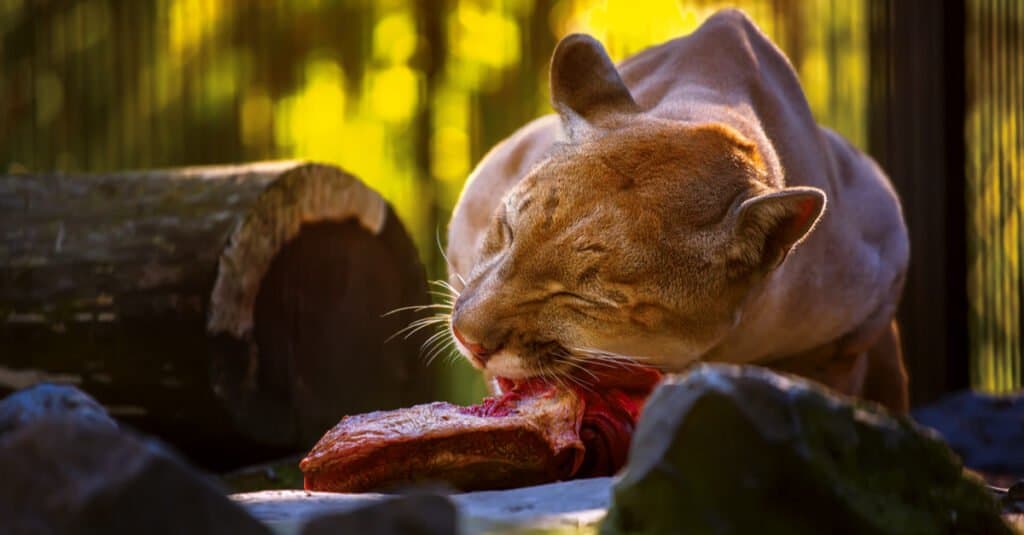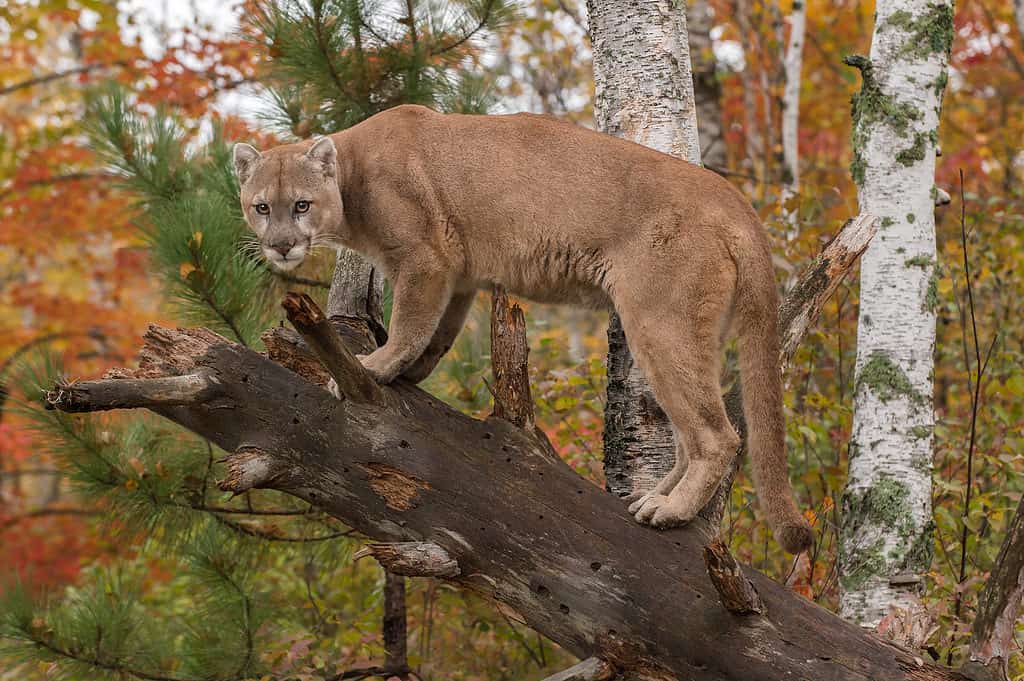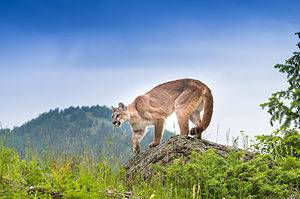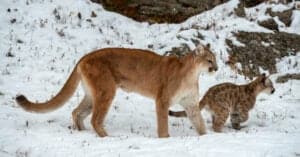Most people understand that carnivores must eat meat to survive. However, our understanding of the kinds of animals that carnivores eat is much more limited. Most exotic carnivores kept in zoos eat standard diets of chicken, beef, or fish to simulate their wild diets. Similarly, carnivores kept as pets, such as cats, snakes, or lizards, typically eat specially formulated supplements, frozen mice, or insects, respectively. On the other hand, we don’t always know exactly what carnivores eat in the wild. For years, animal experts had to find carnivores in the wild and then observe them hunting from a distance. Based on these observations, experts then deduced what animals carnivores prey upon. Today, technologies such as radio collars give experts additional tools to study carnivore diets. With radio collars, experts can track carnivores’ whereabouts and study their diets based on the animal carcasses they leave behind.
Recently, scientists at the Pueblo of Santa Ana Department of Natural Resources (DNR) in New Mexico released data on the meals of a collared mountain lion named “Brokenleg.” Mountain lions often live in remote habitats, which makes studying their dietary habits difficult. By radio-collaring Brokenleg, the Pueblo of Santa Ana DNR team was able to track his diet over a 15-month period. This data allows us to catch a rare glimpse into the diets of these notoriously secretive big cats.
In this article, we’ll examine the mountain lion’s 68 victims and see what patterns emerge. We’ll also discuss mountain lion diets in general and explore how wild mountain lions hunt for food. Keep reading to discover Brokenleg’s meals over 15 months.

An adult mountain lion can run between 40 and 50 miles per hour for short distances. They can jump over 20 feet horizontally —even across canyons — to pursue prey.
©Christina Moraes/Shutterstock.com
What is an Obligate Carnivore?
First off, we should define what it means to be an obligate carnivore. An obligate carnivore is a scientific term used for an animal that must eat meat to survive. Also known as hypercarnivores, these animals eat a diet composed almost entirely of meat. Unlike other meat-eating animals, obligate carnivores cannot properly digest vegetation. As a result, meat makes up 70% or more of their diet.
Scientists classify many animals as obligate carnivores, including tarsiers, minks, dolphins, seals, and walruses. Non-mammalian obligate carnivores include numerous snakes, lizards, birds, and fish. That said, cats likely rank as the most familiar and well-studied obligate carnivores. Lions, tigers, and even domestic house cats must all eat meat to survive. Cats possess a digestive system specifically designed to digest raw flesh. Unlike vegetation, which takes a long time to break down, raw flesh breaks down very quickly. Therefore, digesting raw meat requires only a short amount of digestive tract, while eating vegetation requires a longer, more complex tract. Relatively speaking, a cat’s digestive tract measures shorter than any other animal’s when controlling for body size. This makes it extremely difficult for cats to break down plant matter and explains why they must eat meat to survive.
68 Victims in 15 Months: The Diet of Brokenleg
The Pueblo of Santa Ana DNR spent 15 months tracking the diet of an adult male mountain lion living near the Rio Grande River in New Mexico. They named the cat Brokenleg because he featured a noticeable calcification on his right hind leg. This scar indicated that the mountain lion broke his leg sometime in the past, hence the name Brokenleg. Over the 15-month study window, Brokenleg ate 68 different meals. This works out to around one meal every six to seven days.
Over those 68 meals, Brokenleg feasted on 11 different animal species. Of those 68 meals, badgers stood at the top of the list in terms of total entries. Brokenleg ate badger a grand total of 24 times during the 15-month study window. Based on those numbers, Brokenleg’s diet featured badger in more than 1 out of every 3 meals. Next up on the list was elk, with 17 meals, followed by coyotes, with 9 meals.
Here’s the full breakdown of all 68 meals the mountain lion ate over 15 months:
| Prey Species | Total Meals |
| Mouflon Sheep | 1 |
| Feral Dog | 1 |
| Raccoon | 1 |
| Rabbit | 1 |
| Porcupine | 2 |
| Mule Deer | 2 |
| Pronghorn | 2 |
| Beaver | 8 |
| Coyote | 9 |
| Elk | 17 |
| Badger | 24 |
What do Mountain Lions Eat?
Before going further, we must note that a mountain lion’s diet will vary depending on its environment. The diet of a mountain lion living in the hills around Los Angeles might look very different from the diet of a mountain lion in the Rocky Mountains or a mountain lion living in the pueblos of New Mexico. That said, we can draw general conclusions about their diet from available data.
Mountain lions rank as one of the few remaining extant apex land predators in North America. As such, they eat pretty much anything they can catch. Small mammals in their diet include rabbits, beavers, porcupines, mice, and badgers. Meanwhile, they also prey on large mammals such as moose, elk, deer, pronghorn, and sheep. Additionally, mountain lions will also prey on other large predators, such as coyotes or feral dogs. They may even target small adult or immature black bears.

Mountain lions feed on animals of all sizes: mice, badgers, coyotes, elk, and deer.
©Ipatov/Shutterstock.com
How Much Do Mountain Lions Eat?
An average adult mountain lion can consume between 20 and 30 pounds in a single meal. A meal of this size can likely sustain a mountain lion for three to seven days. However, they often do not eat this much at each meal. As demonstrated by the diet of Brokenleg, mountain lions frequently catch and eat small mammals. A typical American badger weighs between 14 and 16 pounds, while a rabbit may only weigh between 2 and 5 pounds. In other words, a mountain lion will need to eat more often if it catches and eats mostly small prey.
Conversely, an adult elk can weigh anywhere from 500 to 700 pounds. At that size, a single elk could feed a mountain lion for several weeks.
How do Mountain Lions Hunt?
Like most cats, mountain lions are ambush hunters that rely on stealth and cunning to catch their prey. They mostly hunt at night and often approach their prey from behind or from a blind spot.
Mountain lions not only rely on their stealth but also their physical prowess to overwhelm their prey. An adult mountain lion can run between 40 and 50 miles per hour for short distances. They can leap nearly 12 feet directly upward from a sitting position and jump over 20 feet horizontally. Their canine teeth measure 2 inches long and are specially designed for puncturing and tearing flesh. They typically use their teeth to kill their prey by biting the neck and suffocating their victim. Meanwhile, they use their 2.5-inch claws to hold and prevent prey from escaping.

When a mountain lion attacks, it goes in for the kill. Read on to learn how to survive a mountain lion encounter.
©Geoffrey Kuchera/Shutterstock.com
Are Mountain Lions Dangerous?
Mountain lions possess all of the physical tools to pose a danger to humans. They can kill animals much larger than themselves thanks to their sharp claws and teeth and ambush tactics. A bite to the throat from a mountain lion would surely spell doom for even the strongest humans. However, you’re very unlikely to face this type of scenario.
According to estimates, approximately 30,000 mountain lions live in the United States. Upon considering North America as a whole, the total population equals around 40,000. Despite these numbers, mountain lions mostly live in remote, difficult-to-reach areas with few humans present. As a result, you most likely won’t encounter a mountain lion in the wild. Even if you do, you’ll most likely survive the encounter. In the past 100 years, there have been around 120 reported mountain lion attacks, 27 of which were fatal. That works out to a little over 1 attack per year and 1 fatality every four years.
How to Survive a Mountain Lion Attack
If you encounter a mountain lion in the wild, remember to stay calm. Do not try to approach the lion or turn and run away. Try to provide the lion with a means of escaping the situation, and don’t give it an excuse to chase you. Instead, stand your ground, face the mountain lion, and slowly back away. Additionally, don’t try to bend down or crouch – the mountain lion may take this as a weakness and see you as prey. Stand tall, or better yet, try to make yourself look bigger. If the mountain lion starts to advance upon you, yell, shout, and throw objects at the mountain lion. Aim objects (such as sticks or stones) at its body to try and drive it off. Lastly, if a mountain lion does attack you, fight back with all your strength. Protect your neck and eyes, and aim blows at the lion’s face.
Up Next…
- What Do Mountain Lions Eat? 20 Animals in Their Diet
- Mountain Lion (Cougar) Population by State
- Remember P-22 The Famous Los Angeles Mountain Lion that Stalked Celebrity Backyards
The photo featured at the top of this post is © Kwadrat/Shutterstock.com
Thank you for reading! Have some feedback for us? Contact the AZ Animals editorial team.







